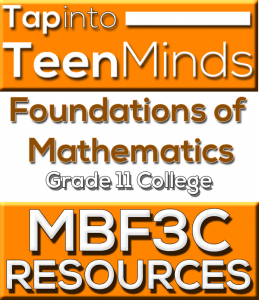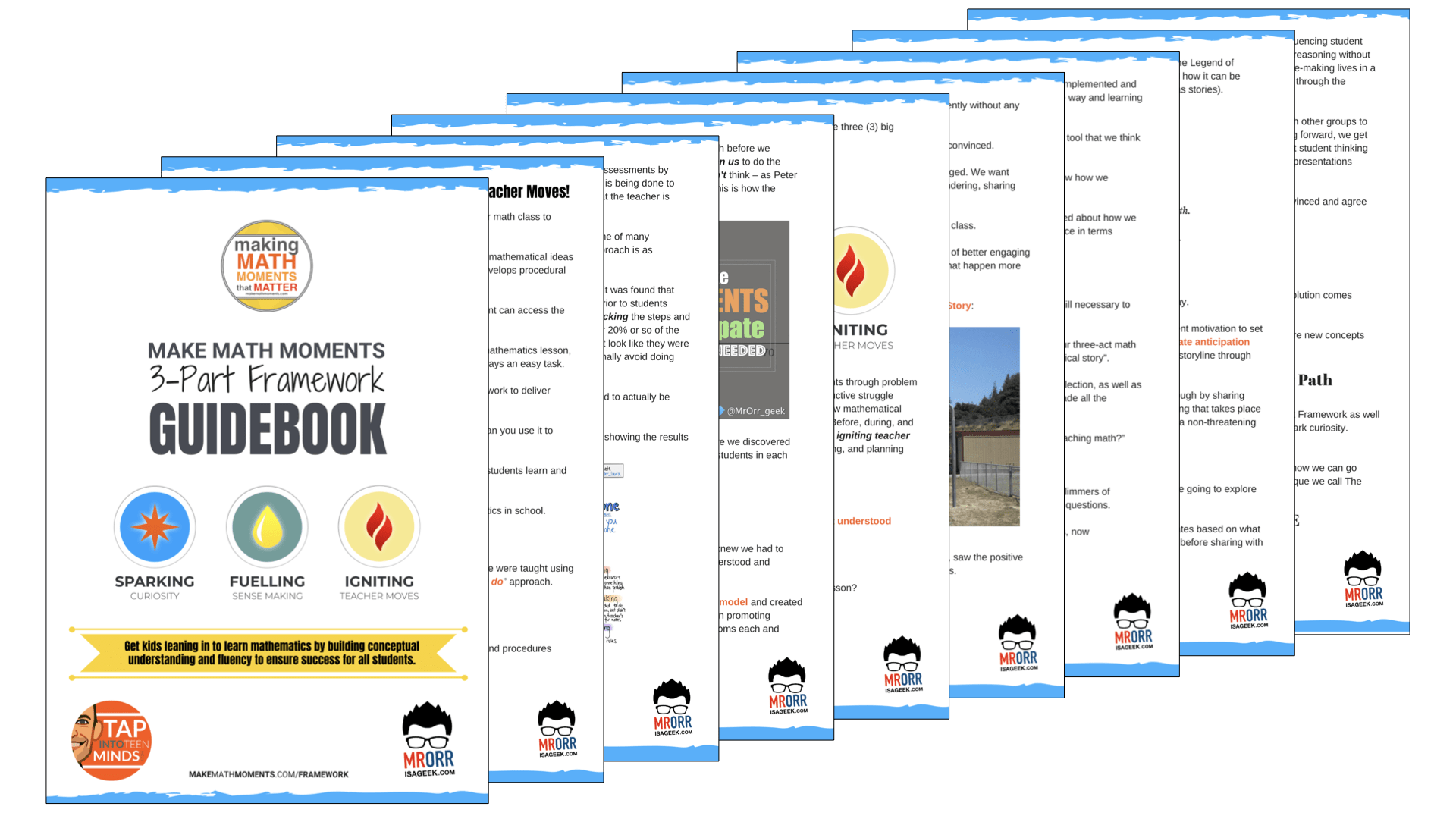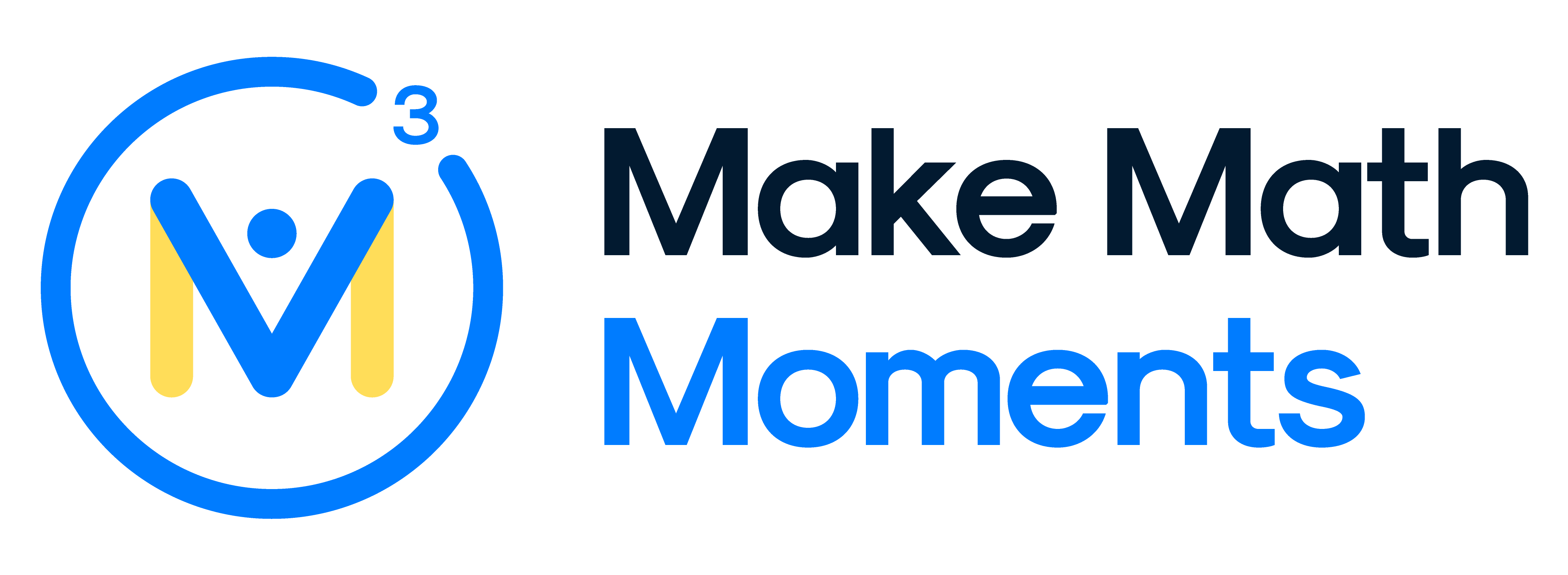MBF3C FOUNDATIONS OF MATHEMATICS – GRADE 11 MATH – COLLEGE PREPARATION
MBF3C Grade 11 College Course Description
This course enables students to broaden their understanding of mathematics as a problem solving tool in the real world. Students will extend their understanding of quadratic relations; investigate situations involving exponential growth; solve problems involving compound interest; solve financial problems connected with vehicle ownership; develop their ability to reason by collecting, analysing, and evaluating data involving one variable; connect probability and statistics; and solve problems in geometry and trigonometry. Students will consolidate their mathematical skills as they solve problems and
communicate their thinking.
Prerequisite: Foundations of Mathematics, Grade 10, Applied

3 Act Math Tasks
MBF3C Grade 11 College Real World Math Problems
Access 3 Act Math Tasks related to the MBF3C Grade 11 College Math Course.
MBF3C Grade 11 Math Course Notes and Handouts
MBF3C – Unit 1 – Trigonometry
| Sec. 1.1 – Revisit the Primary Trigonometric Ratios
Page 13-15 #1-4, 6, 8, 10, 12 |
| Sec. 1.2 – Solve Problems Using Trigonometric Ratios
Page 21-23 #1-6, 12, 13 |
| Sec. 1.3 – The Sine Law
Page 32-33 #1-6, 8 |
| Sec. 1.4 – The Cosine Law
Page 39-41 #1-3, 5-7, 9 |
| Sec. 1.5 – Make Decisions Using Trigonometry
Page 48-51 #1-10 |
MBF3C – Unit 2 – Probability
| Sec. 2.1 – Probability Experiments
Page 66-67 #1-7 |
| Sec. 2.2 – Theoretical Probability
Page 73-74 #1-9 |
| Sec. 2.3 – Compare Experimental and Theoretical Probabilities
Page 82-83 #1-6, 8a |
| Sec. 2.4 – Interpret Information Involving Probability
Page 90-92 #1-8 |
MBF3C – Unit 3 – One Variable Statistics
| Sec. 3.1 – Sampling Techniques
Page 106-109 #1-5, 7-10 |
| Sec. 3.2 – Collect and Analyse Data
Page 114-116 #1-10 |
| Sec. 3.3 – Display Data (Day 1)
Page 125-127 #1-3,6 |
| Sec. 3.3 – Display Data (Day 2)
Page 125-128 #4, 5, 7, 9, 11 |
| Sec. 3.4 – Measures of Central Tendency
Page 136-139 #1-3, 6-8 |
| Sec. 3.5 – Measures of Spread (Day 1)
Page 145-147 #5, 6, 7ab, 8, 10, 11 |
| Sec. 3.5 – Measures of Spread (Day 2)
Page 145-147 #1-4, 9, 12 |
| Sec. 3.6 – Types of Distributions
Page 153-155 #1-7 |
MBF3C – Unit 4 – Quadratic Relations I
| Sec. 4.1 – Modelling With Quadratics (Part 1)
Page 174-175 #1, 3, 6 |
| Sec. 4.1 – Modelling With Quadratics (Part 2)
Page 174-176 #2, 4, 7, 9 |
| Sec. 4.2 – The Quadratic Relation y = ax2 + k
Page 190-193 #1-3, 4(a,c,e,g), 7(a,c,e), 8 |
| Sec. 4.3 – The Quadratic Relation y = a(x – h)2
Page 200-203 #1-4, 5(a,c), 7 |
| Sec. 4.4 – The Quadratic Relation y = a(x – h)2 + k
Page 212-217 #1, 2(a,c,e,g), 6 |
| Sec. 4.5 – Interpret Graphs of Quadratic Relations
Page 222-225 #1(a,c,e,g), 2, 4, 5 |
| Sec. 4.6 – Graphing Quadratics in Vertex Form
Complete Handouts |
MBF3C – Unit 5 – Quadratic Relations II
| Sec. 5.1 – Expanding Binomials
Page 238-241 #1, 2, 3-7(a,c,e) |
| Sec. 5.2 – Change From Vertex Form to Standard Form
Page 245-247 #1-4(a,c,e), 6, 7 |
| Page 253-255 #1-3 |
| Sec. 5.4 – Factor Trinomials of Form y = ax2 + bx + c
Page 259-263 #1-7(a,c,e) |
| Sec. 5.5 – The x-Intercepts of a Quadratic Relation
Page 271-275 #1-2, 3-5(a,c,e), 6, 7(a,c,e) |
MBF3C – Unit 7 – Exponents
| Sec. 7.1 – Exponent Rules
Page 360-363 #1-5, 9, 10 |
| Sec. 7.2 – Zero and Negative Exponents
Page 367-371 #1-3, 6-7(a,c,e), 8 |
| Sec. 7.3 – Investigate Exponential Relationships
Page 377-381 #1-3, 6, 7 |
| Sec. 7.4 – Exponential Relations
Page 390-394 #1-4, 6 |
| Sec. 7.5 – Exponential Growth and Decay
Page 401-405 #1(b,c,d), 2(b,c), 5(a,b), 6 |
| Sec. 7.6 – Solve Problems Involving Exponential Growth and Decay
Page 410-413 #1-7 |
MBF3C – Unit 8 – Compound Interest
| Page 428-429 #1-7 |
| Page 432-435 #1-9 |
| Page 439-441 #1, 2-3(a,b), 4, 5, 8, 9 |
| Page 450-453 #3-10 |
MBF3C – Unit 9 – Personal Finance
| Page 465-467 #2-5, 7-9 |
| Page 472-473 #2, 3, 6, 7, 8, 10 |
| Page 479-481 #1, 2, 4-8 |
| Page 486-487 #1, 5, 6, 8 |
| Page 493-495 #1-9 |
MBF3C Grade 11 College Mathematics
Strands and Overall Expectations
Mathematical Models
- MM1 – make connections between the numeric, graphical, and algebraic representations of quadratic relations, and use the connections to solve problems;
- MM2 – demonstrate an understanding of exponents, and make connections between the numeric, graphical, and algebraic representations of exponential relations;
- MM3 – describe and represent exponential relations, and solve problems involving exponential relations arising from real-world applications.
Personal Finance
- PF1 – compare simple and compound interest, relate compound interest to exponential growth, and solve problems involving compound interest;
- PF2 – compare services available from financial institutions, and solve problems involving the cost of making purchases on credit;
- PF3 – interpret information about owning and operating a vehicle, and solve problems involving the associated costs.
Geometry and Trigonometry
- GT1 – represent, in a variety of ways, two-dimensional shapes and three-dimensional figures arising from real-world applications, and solve design problems;
- GT2 – solve problems involving trigonometry in acute triangles using the sine law and the cosine law, including problems arising from real-world applications.
Data Management
MAKE MATH MOMENTS WITH OUR NEW
PROBLEM BASED MATH UNITS
ACCESS FULL PROBLEM BASED MATH LESSONS
Each Make Math Moments Problem Based Lesson consists of a Teacher Guide to lead you step-by-step through the planning process to ensure your lesson runs without a hitch!
Each Teacher Guide consists of:
- Intentionality of the lesson;
- A step-by-step walk through of each phase of the lesson;
- Visuals, animations, and videos unpacking big ideas, strategies, and models we intend to emerge during the lesson;
- Sample student approaches to assist in anticipating what your students might do;
- Resources and downloads including Keynote, Powerpoint, Media Files, and Teacher Guide printable PDF; and,
- Much more!
Each Make Math Moments Problem Based Lesson begins with a story, visual, video, or other method to Spark Curiosity through context.
Students will often Notice and Wonder before making an estimate to draw them in and invest in the problem.
A great example of this is one of our more recent units called Piggy Bank.
After student voice has been heard and acknowledged, we will set students off on a Productive Struggle through a prompt related to the Spark context.
These prompts are given each lesson with the following conditions:
- No calculators are to be used; and,
- Students are to focus on how they can convince their math community that their solution is valid.
Students are left to engage in a productive struggle as the facilitator circulates to observe and engage in conversation as a means of assessing formatively.
The facilitator is instructed through the Teacher Guide on what specific strategies and models could be used to make connections and consolidate the learning from the 3 act math lesson.
At the end of each lesson, consolidation prompts and/or extensions are crafted for students to purposefully practice and demonstrate their current understanding.
Facilitators are encouraged to collect these consolidation prompts as a means to engage in the assessment process and inform next moves for instruction.
At the end of each lesson, consolidation prompts and/or extensions are crafted for students to purposefully practice and demonstrate their current understanding.
At the end of each lesson, consolidation prompts and/or extensions are crafted for students to purposefully practice and demonstrate their current understanding.
Facilitators are encouraged to collect these consolidation prompts as a means to engage in the assessment process and inform next moves for instruction.
In multi-day units of study, Math Talks are crafted to help build on the thinking from the previous day and build towards the next step in the developmental progression of the concept(s) we are exploring.
Each Math Talk is constructed as a string of related problems that build with intentionality to emerge specific big ideas, strategies, and mathematical models.

SPARK
Curiosity

FUEL
Sense Making

IGNITE
Your Teacher Moves
MAKE MATH MOMENTS WITH THE 3-PART FRAMEWORK

The Make Math Moments core lesson design should be your go-to math lesson planning framework to spark curiosity, fuel student sense making, and ignite your teacher moves.
Download the Digital Guidebook now!
TRANSFORM YOUR ASSESSMENT PROCESS TO:
ASSESS FOR GROWTH

Our latest math educator PD course, teaches how we can transform our assessment and evaluation process from one that promotes assessment to label to assesses for learning through problem based math lessons. Let’s Grade for Growth!
Module 1 is NOW OPEN ACCESS for you to enjoy, but for a limited time only.
